 Visual illusions and mathematics
Visual illusions and mathematics 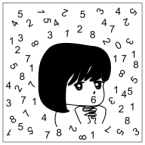
錯視と数学
非線形数理東京フォーラム「人と自然の数理」
東京大学(University of Tokyo)駒場キャンパス・数理科学研究科大講義室
February 2 (Sat) - 3 (Sun), 2008
 Visual illusions and mathematics
Visual illusions and mathematics 
錯視と数学
北岡 明佳(Akiyoshi Kitaoka)
(立命館大学(Ritsumeikan University) 文学部 心理学専攻) email
since January 30, 2008
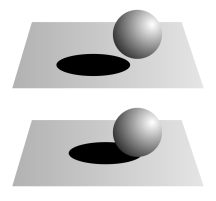 Today's talk
Today's talk 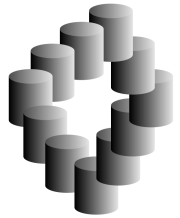
1. Spiral illusion
2. Retinal coordinates and illusion
3. Color illusion
4. Anomalous motion illusion: retinal-slip-dependent type
5. Anomalous motion illusion: "automatic" type
1. Spiral illusion
an illusion that concentric circles appear to be spirals
渦巻き錯視
同心円(中心が同じ複数の円)が渦巻きに見える現象
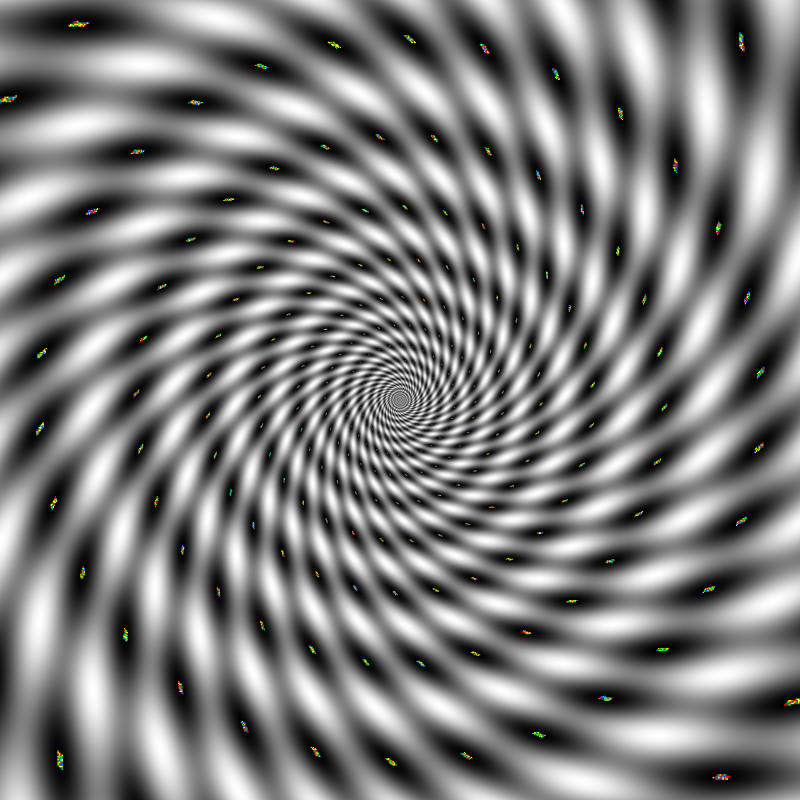
"Spiral warp"
Concentric rings appear to be spirals.
Copyright Akiyoshi Kitaoka 2007 (June 29)
equiangle = 45 deg
The spiral illusion of the Zöllner illusion:
Kitaoka, A., Pinna, B., and Brelstaff, G. (2001). New variations of spiral illusions. Perception, 30, 637-646.
"Spiral blood vessel"
Red concentric rings appear to be spirals.
Copyright Akiyoshi Kitaoka 2007 (June 26)
The spiral illusion of the Fraser illusion (Fraser spiral):
Fraser, J. (1908) A new visual illusion of direction. British Journal of Psychology, 2, 307-320.
The Fraser illusion of this type:
Skillen, J., Whitaker, D., Popple, A., and McGraw, P. V. (2002) The importance of spatial scale in determining illusions of orientation. Vision Research, 42, 2447-2455.
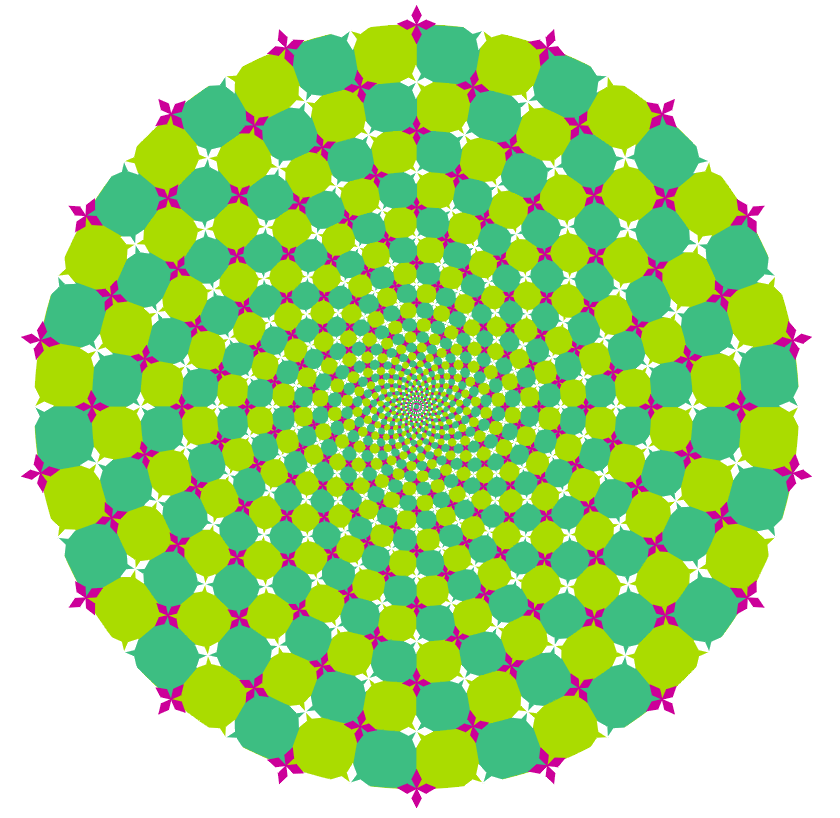
"Primrose's spirals"
Concentric arrays of "flowers" appear to be spirals.
Copyright A.Kitaoka 2002
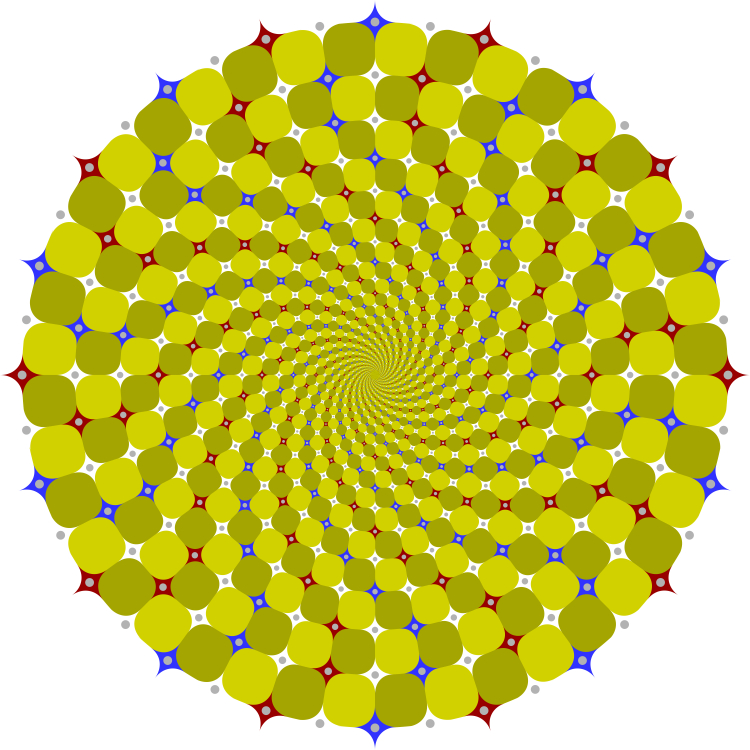
"Neural circuit spirals 2"
Concentric circles appear to be spirals (going to the center by rotating clockwise). Moreover, the inner part appears to rotate clockwise (counterclockwise) when observers approach (move away from) the image keeping their eyes fixed at the center.
Copyright Akiyoshi Kitaoka 2007 (August 7)
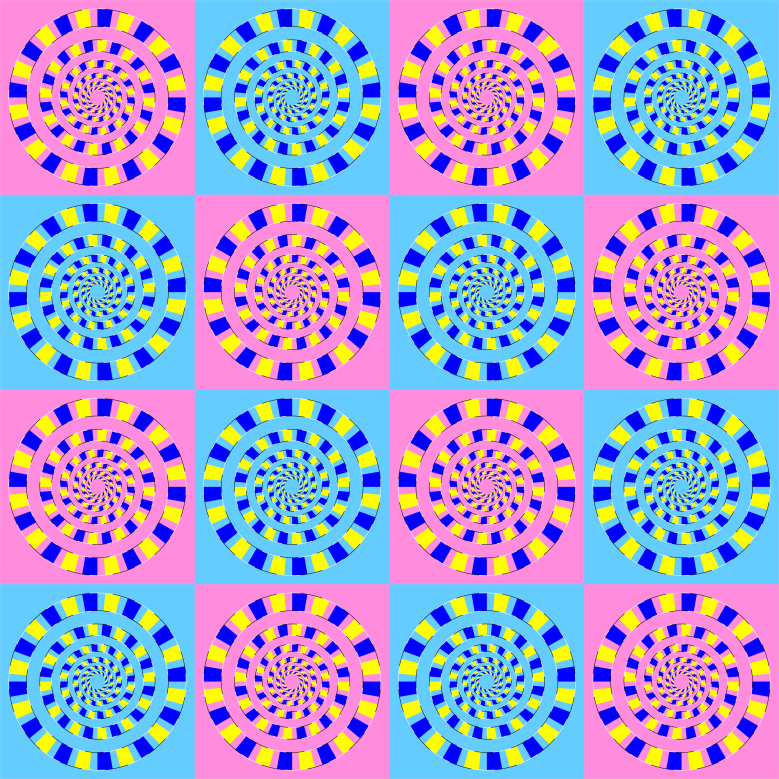
"Packed spirals"
Concentric rings appear to be spirals. Moreover, each set of rings appears to rotate.
Copyright Akiyoshi Kitaoka 2006 (June 13)

"Songs of
frogs"
(a remake)
Concentric arrays of dots appear to be spirals.
Copyright Akiyoshi Kitaoka 2008 (January 2008)
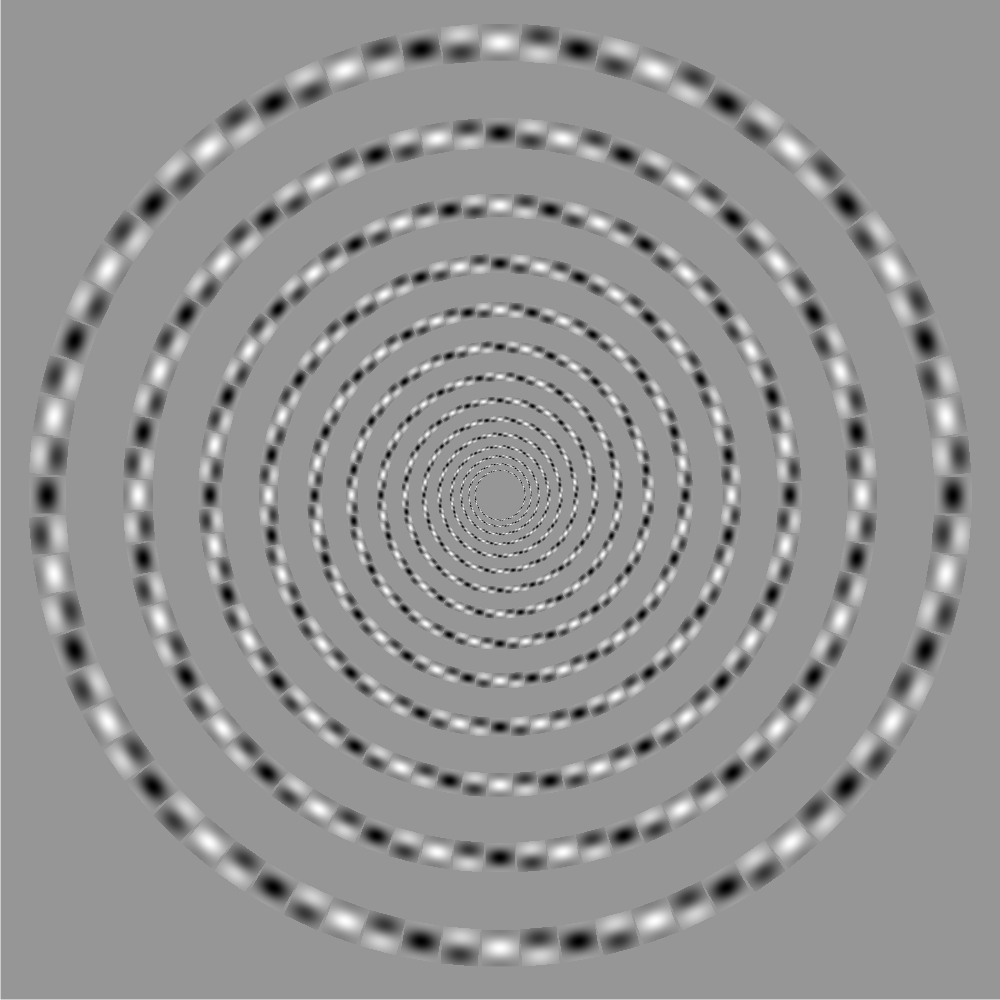
"Cyanophyceae spiral"
Concentric circles appear to be a spiral.
Copyright Akiyoshi Kitaoka 2007 (August 29)
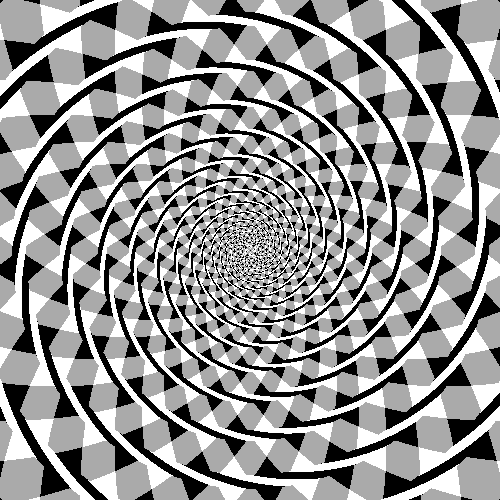
First presented by Fraser (1908); Reproduced by Akiyoshi Kitaoka (2003)
Fraser's spiral
The term "spiral illusion" had long referred to the spiral illusion of the Fraser illusion (Fraser, 1908) before we elucidated that any tilt illusion can form spiral illusion (Kitaoka, Pinna and Brelstaff, 2001). This page shows a copy of Fraser's spiral produced by PC programming. <2003/8/30>
Fraser, J. (1908) A new visual illusion of direction. British Journal of Psychology, 2, 307-320.
Kitaoka, A., Pinna, B., and Brelstaff, G. (2001). New variations of spiral illusions. Perception, 30, 637-646. PDF
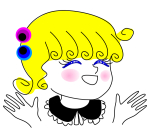 Handout
Handout
Catalogue of spiral illusions (in Japanese)
北岡明佳 (2006) 渦巻き錯視のメカニズム じっきょう数学資料, 52, 13-15. PDF
 Suggested function
Suggested function
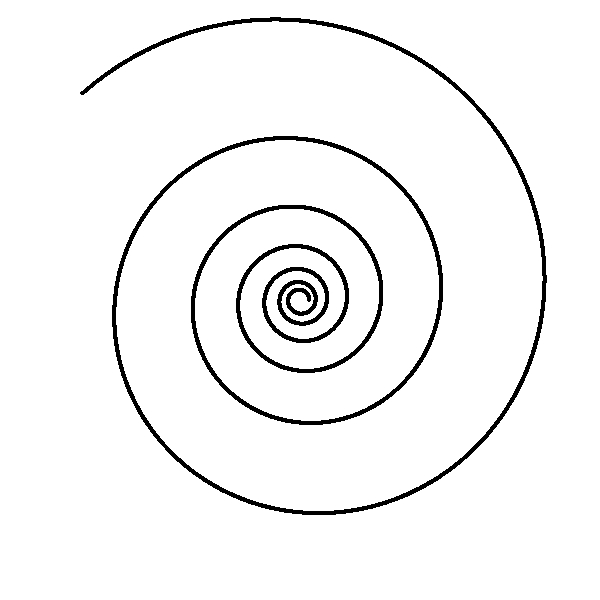
Bernoulli's spiral
r = a exp (k θ)
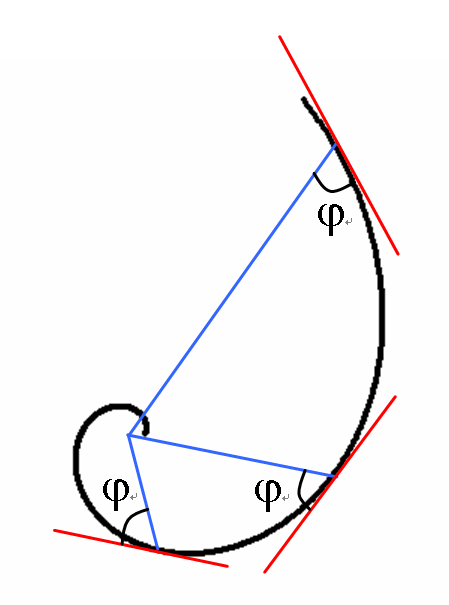
= equiangular spiral
k = 1 / tan (φ)
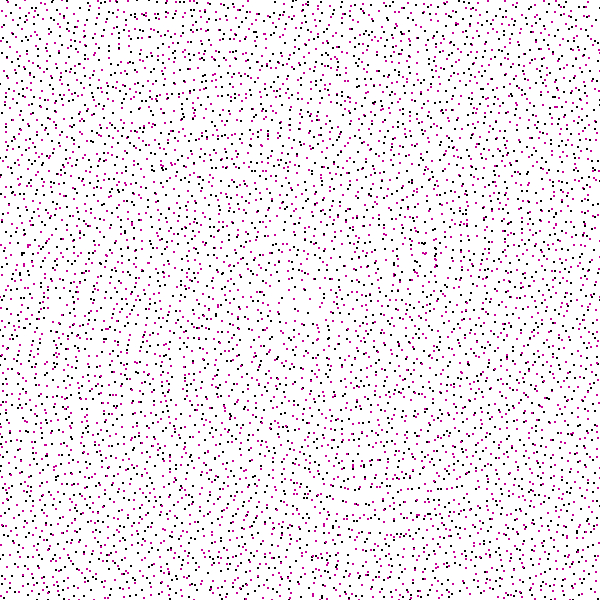
Spiral Glass pattern
φ = 70º
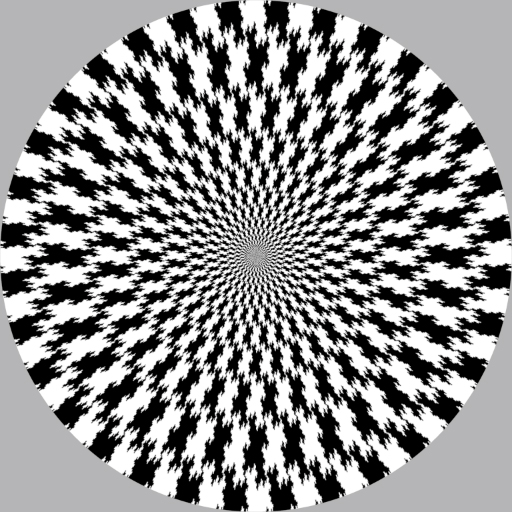
"Fractal spiral illusion"
Concentric rings made up of fractal islands appear to form spirals.
Copyright Hitoshi & Shinobu Arai
2007
from Professor Hitoshi Arai,
Graduate School of Mathematical Sciences, University of Tokyo, October 4,
2007
北岡明佳のコメント: 原理としてはフレーザー錯視のようですが、それよりもなによりも、世界初のフラクタル錯視図形 なのではないでしょうか!? 新井先生の視覚数学e研究室報告に、この錯視の論文が出ました。 <2007年10月4日>
2. Retinal coordinates and illusion
Is line perspective an illusion?
網膜座標系と錯視
線遠近法って錯視なの?
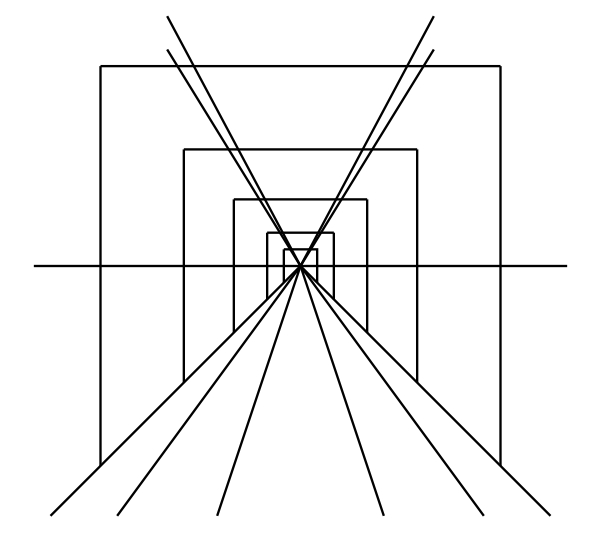
 Handout
Handout
Kitaoka, A. (2007) Psychological approaches to art. Japanese Journal of Psychonomic Science,26, 97-102. PDF
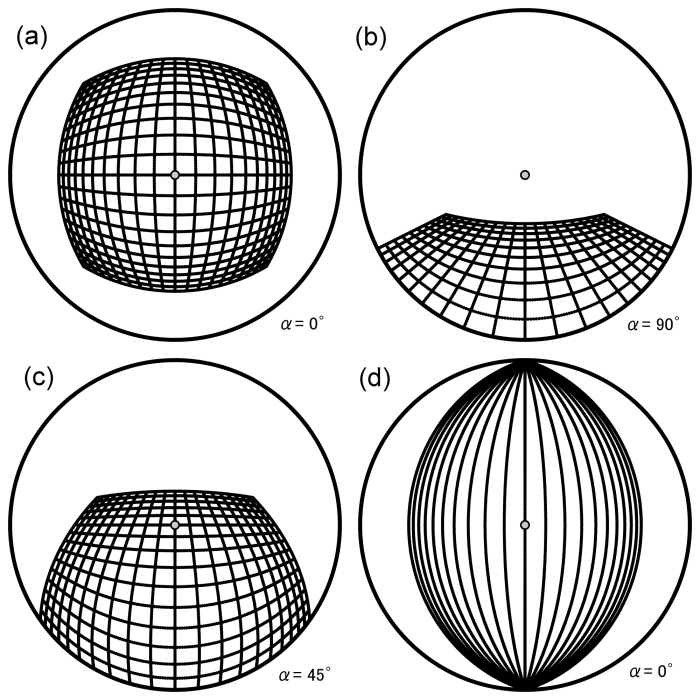
Figure 1. An instance of retinal coordinates. Suppose that twenty by twenty squares (each being 10 cm x 10 cm) are drawn at the center of an infinitely-extended flat plane and observed from 50 cm apart. (a) When the plane is perpendicular to the visual axis, the mesh appears to bulge out though it really has no curves. (b) When the visual axis is parallel to the plane, the lines parallel to the visual axis appear to converge at the center of the visual field while the lines perpendicular to the visual axis (except those that cross the visual axis) appear to curve outward. (c) When the plane is observed obliquely, both (bulging and converging) appearances coexist. (d) Parallel lines on a plane perpendicular to the visual axis meet at two points on the surrounding circle. The gray circle at the center in each panel represents the foveal vision. The radius of the circle is 90 degree of visual angle.
 Given equations
Given equations
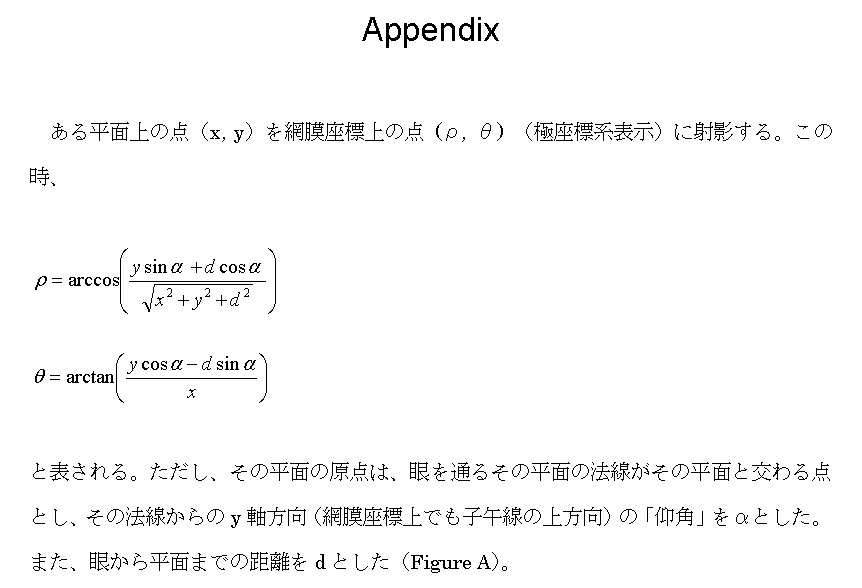
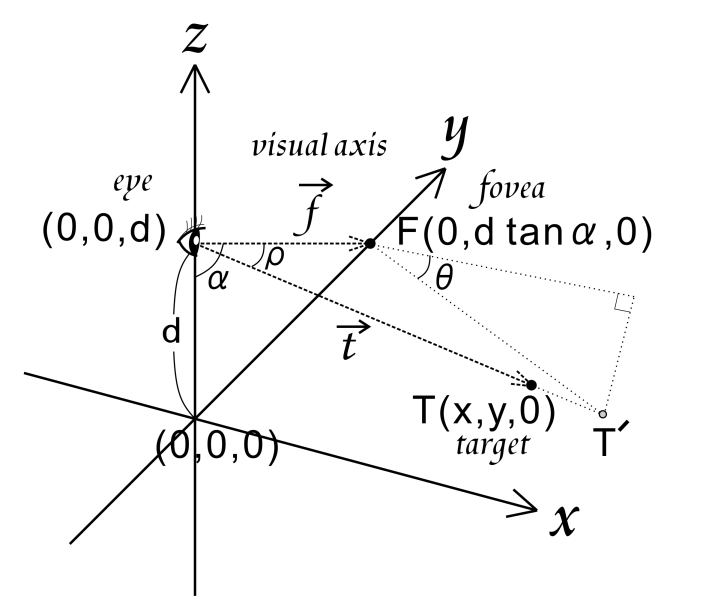
Figure Appendix. The method to obtain the retinal coordinates (ρ,θ) from the visual world. Suppose that the seen object is placed on the x-y plane where a target point T (x, y, 0) is located, and that an observing eye is located on the z-axis with the height of "d". "α" is the angle between the visual axis and the z-axis when the eye sees a point F (foveal point) that is located on the y-axis. The visual angle "ρ" of the target point is the angle between the line from the eye to the foveal point F (vector f) and the line from the eye to the target point T (vector t). The visual angle ρ is obtained from these two vectors. The angle θ is given as the angle between the line parallel to the x-axis through the foveal point F and the line from the foveal point F to another point T´ where the extension of vector t meets the plane that is perpendicular to the visual axis (or vector f) and passes through the foveal point F.
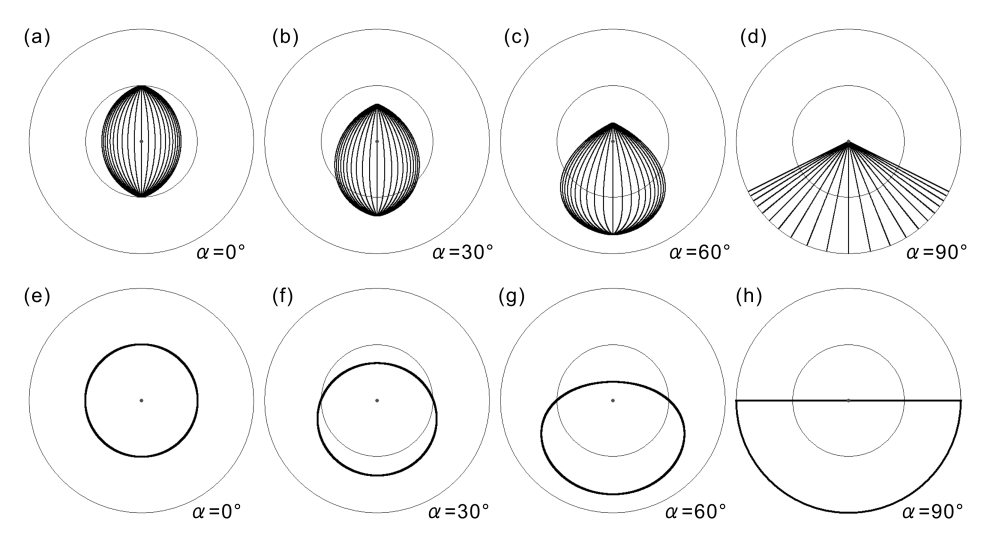
Figure 2. Extended retinal coordinates. The radius of the outer circle represents 180 degrees of “visual angle” while the radius of the inner one shows 90 degrees of visual angle. (a) The image of Figure 1d is placed in these coordinates. (b) and (c) The same image is seen obliquely. (d) The same image is seen in parallel to the plane. (e)-(h) The thick line shows the line at infinity of a plane within which the entire plane is represented.
Line perspective is not an illusion, but mathematics!
3. Color illusion
Contrast (-) vs. assimilation (+)
色の錯視
対比(+)と同化(-)
"The ground family"
The left pegion appears to be yellowish, but the color is the same white as the right.
Copyright Akiyoshi .Kitaoka 2007 (March 12)
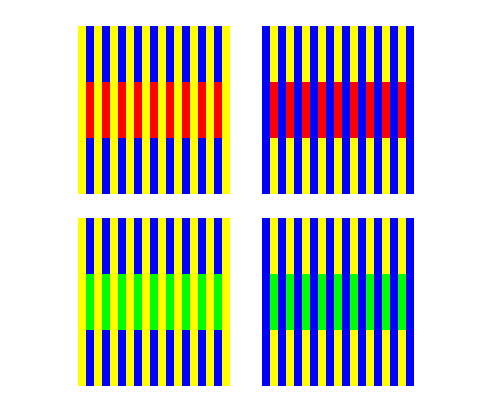
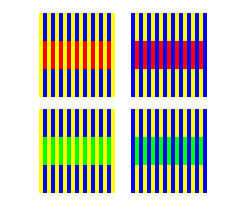
Munker illusion
The orange and purple-red shown in the upper row are the same red, and the yellowish-green and bluish green displayed in the lower row are the same green.
Munker, H. (1970) Farbige Gitter, Abbildung auf der Netzhaut und übertragungstheoretische Beschreibung der Farbwahrnehmung. Habilitationsschrift, Ludwig-Maximilians-Universität, München.
 Handout PDF
Handout PDF
"Takeda Shingen"*
*Takeda Shingen = a sengoku-daimyo (leader in the Warring States period in the 15th and 16th century in Japan)
There appear to be pale-yellow and dark-blue spirals. Actually, in the left half, they are white (R=255, G=255, B=255) and black (R=0, G=0, B=0), respectively. On the other hand, in the right half, they are yellow (R=255, G=255, B=0) and blue (R=0, G=0, B=255), respectively.
Copyright Akiyoshi .Kitaoka 2007 (March 12)
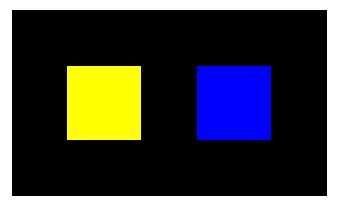
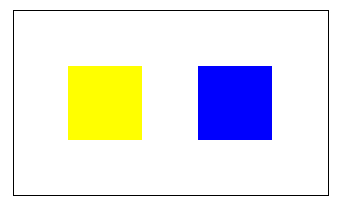
Color sample
"Furin-kazan"*
*Furin-kazan is a slogan of Takeda Shingen
There appear to be white, black, yellow and blue spirals as they really are.
Copyright Akiyoshi .Kitaoka 2007 (March 12)
 Suggested equations
Suggested equations
Induced color 1 = (+Red) + (-Magenta) = Red + Green = Yellow
Induced color 2 = (-Red) + (+Magenta) = Cyan + Magenta = Blue
4. Anomalous motion illusion
retinal-slip-dependent type
静止画が動いて見える錯視
網膜像の動きによって引き起こされるタイプ
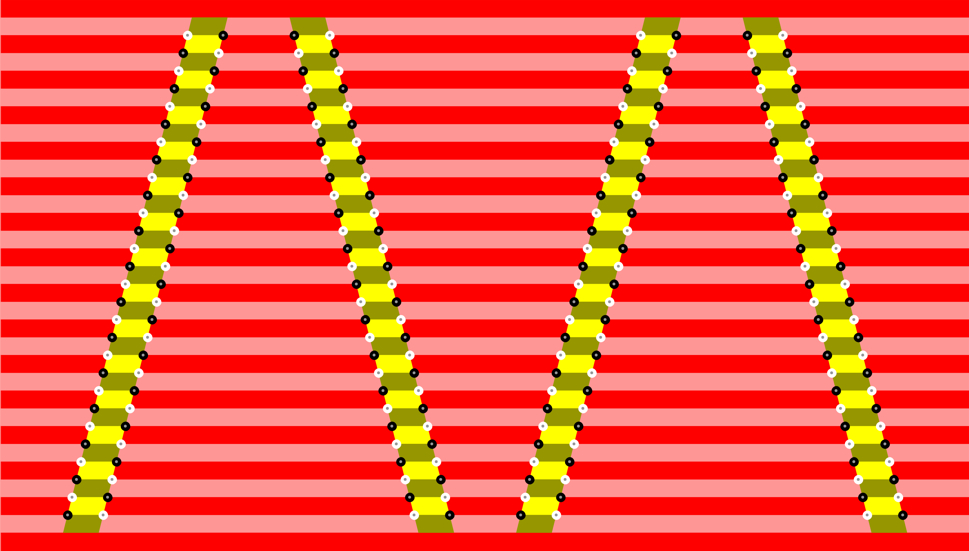
"Makudonarudo"*
A remake
*McDonald's pronounced in Japanese
Bars appear to move laterally.
Copyright Akiyoshi Kitaoka 2005 (November 3)
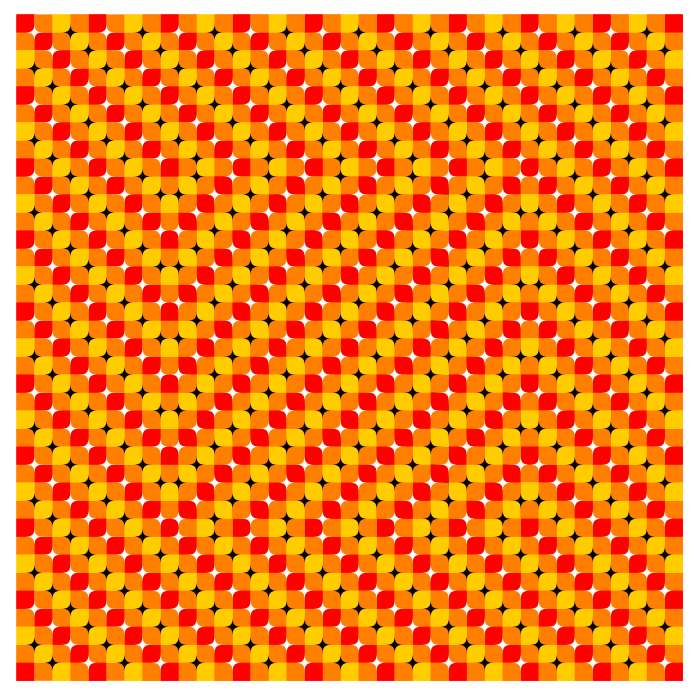
"The autumn color
swamp"
re-renewal version
The inset appears to move.
Copyright A.Kitaoka 2000, 2003, 2007
 Handout PDF
Handout PDF
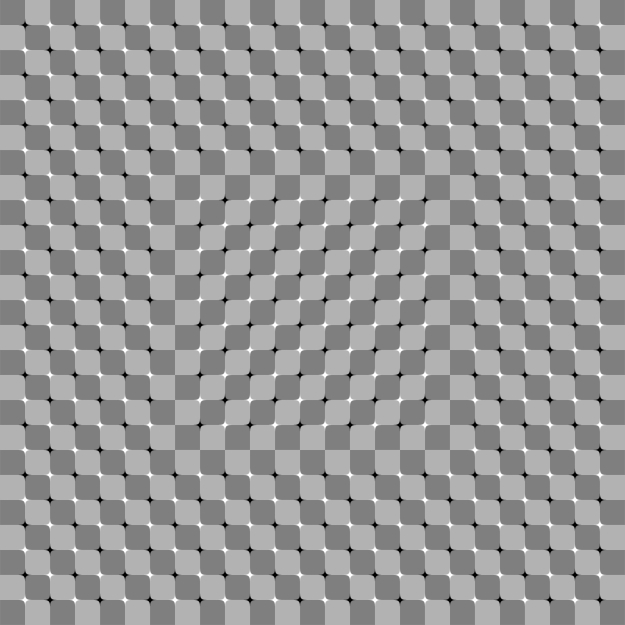
Illusion of Y-junctions
The inset appears to move according to retinal slips of the image. For example, the inset appears to slide leftward when upward retinal slip occurs; the inset appears to move upward when leftward retinal slip occurs. Moreover, there is a tilt illusion. For example, the vertical edges of the inset appear to tilt clockwise while the horizontal ones counterclockwise.
Kitaoka, A., Pinna, B., and Brelstaff, G. (2001). New variations of spiral illusions. Perception, 30, 637-646. PDF
Kitaoka, A., Pinna, B., and Brelstaff, G. (2004). Contrast polarities determine the direction of Cafe Wall tilts. Perception, 33, 11-20. PDF
Kitaoka, A. (2007) Tilt illusions after Oyama (1960): A review. Japanese Psychological Research, 49, 7-19. PDF
 Suggested underlying mechansims
Suggested underlying mechansims
1. Components of lower spatial frequency (given by wavelet transform?)
2. Components of tilt illusions (given by wavelet transform?)
1. Components of lower spatial frequency?
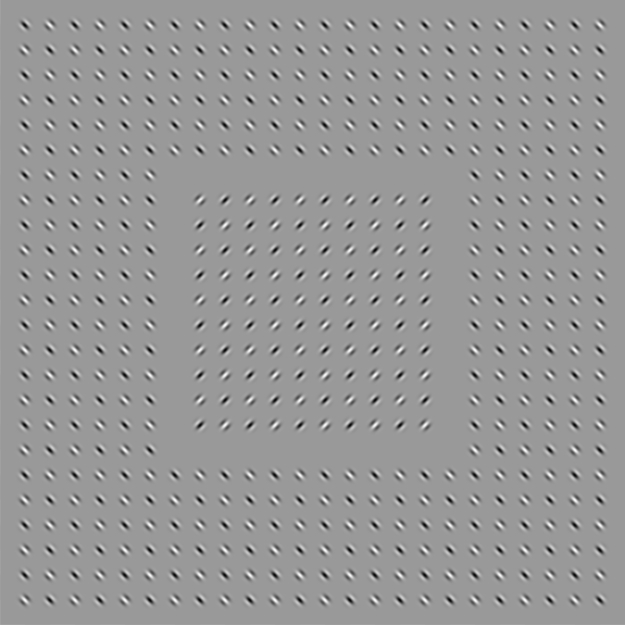
"Gabor patch drift illusion"
The inner square region appears to move. This is a translational representation of the Gurnsey-Morgan illusion.
Copyright Akiyoshi Kitaoka 2007 (August 6)
cf.
Gurnsey, R., Sally, S. L., Potechin, C., and Mancini, S. (2002) Optimising the Pinna-Brelstaff illusion Perception, 31, 1275-1280.
Morgan M, 2002 ``Running rings around the brain'' The Guardian Thursday, 24 January 2002; http://www.guardian.co.uk/Archive/Article/0,4273,4341518,00.html; http://www.staff.city.ac.uk/~morgan/TheWheel.pdf
2. Components of tilt illusions?
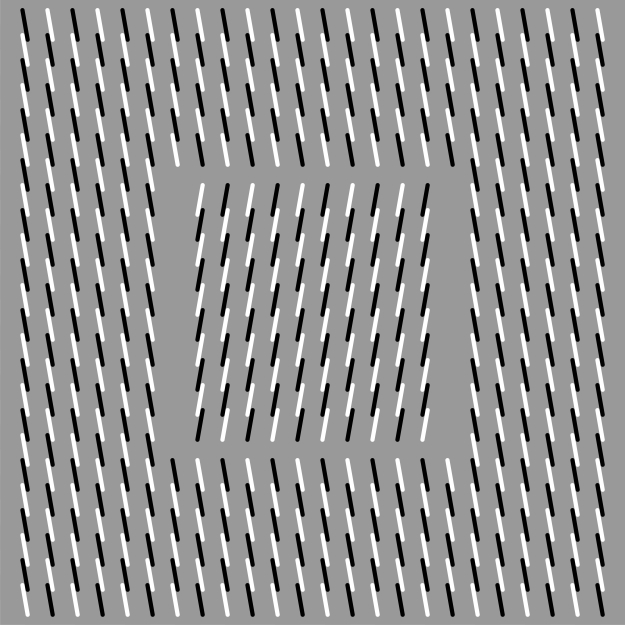
The inset appears to move horizontally when vertical retinal slips occur.
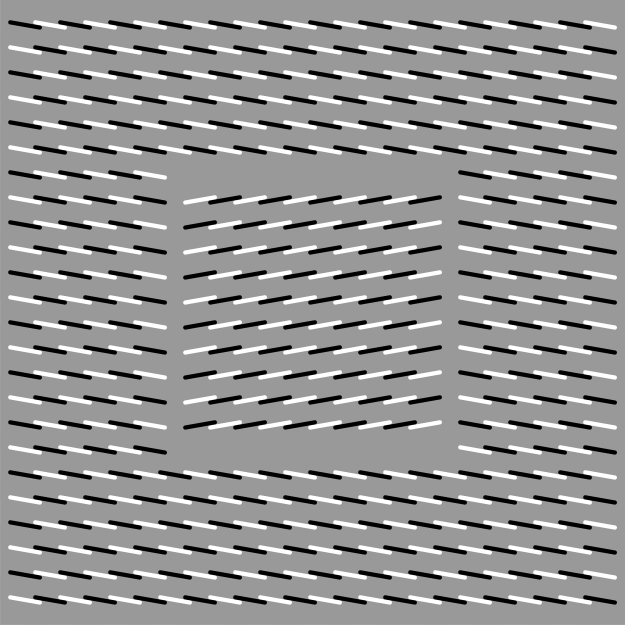
The inset appears to move vertically when horizontal retinal slips occur.
The illusion shown below can only be explained with mechanism 2

Illusion of fringed edges
The inset appears to move leftward when an upward retinal slip occurs.
The inset appears to move rightward when an downward retinal slip occurs.
The inset appears to move upward when an rightward retinal slip occurs.
The inset appears to move downward when an leftward retinal slip occurs.
The vertical edges of the inset appears to tilt clockwise.
The horizontal edges of the inset appears to tilt clockwise.
Newton Press (Ed.), A. Kitaoka (Supervisor)
(2007) Newton magazine book: Special
issue "How is the brain deceived? Perfect demonstration of visual
illusions" (published in
October 2007) ![]()
Kitaoka, A. and Murakami, I. (2007) Rotating Ouchi illusion. Poster presentation in VSS2007, Sarasota, Florida, USA, May 15, 2007. Abstract (MS-Word) VSS2007 Abstract (including all) (PDF)
(Kitaoka, A., & Murakami, I. (2007). Rotating Ouchi illusion [Abstract]. Journal of Vision, 7(9):984, 984a, http://journalofvision.org/7/9/984/,doi:10.1167/7.9.984.)
5. Anomalous motion illusion
"Automatic" type
静止画が動いて見える錯視
「自動的」に動いて見えるタイプ
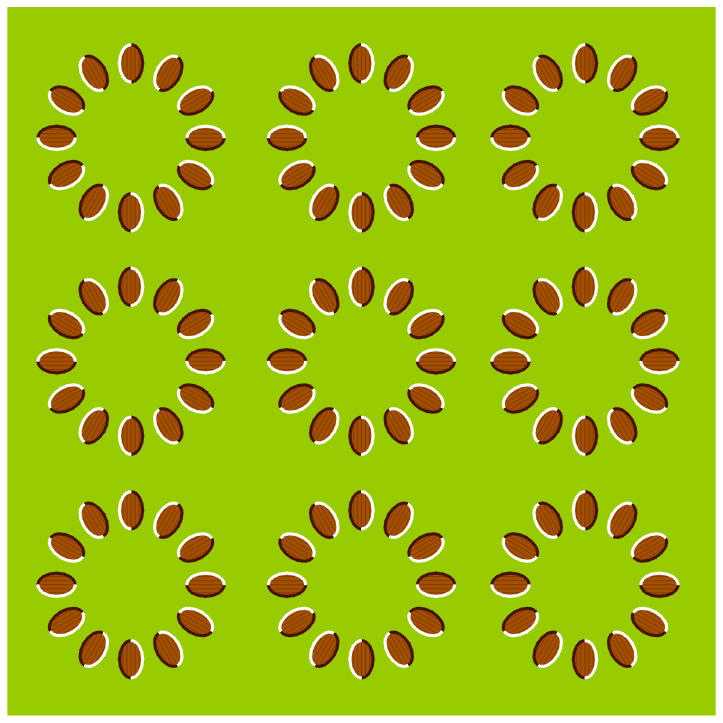
"Dongururin"*
renewal version
*Rotation of donguri (acorns). "Gururin" means rotation.
Rings of donguri appear to rotate.
Copyright A.Kitaoka 2003 (July 3, 2003)
2004/4/17
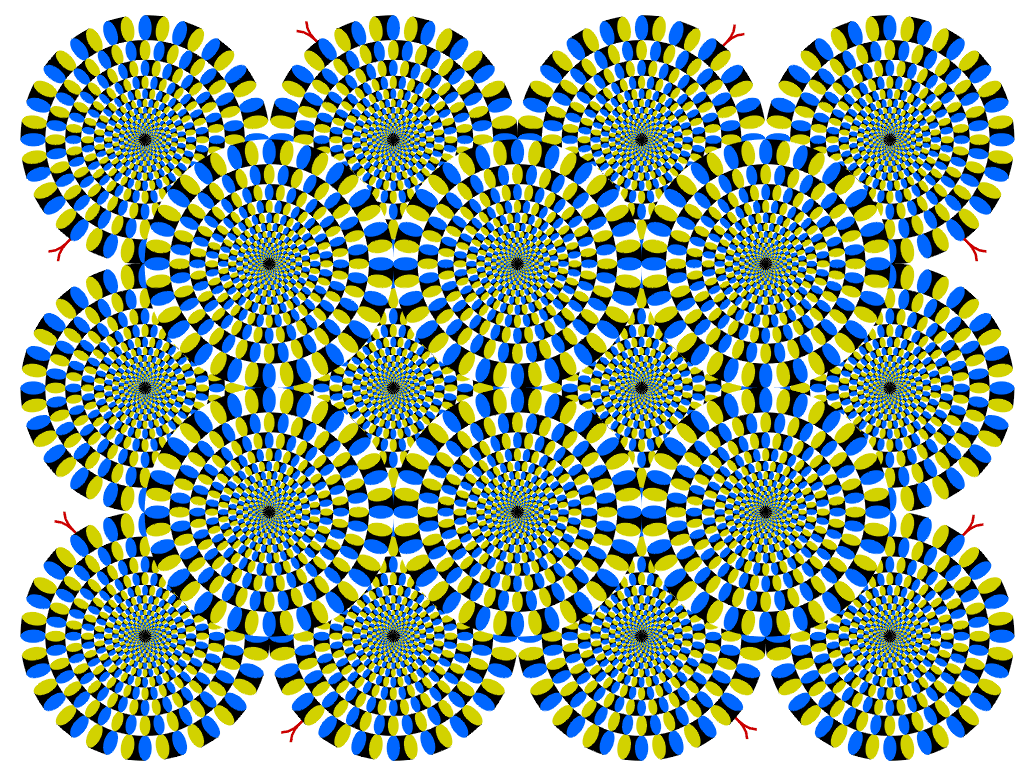
"Rotating snakes"
Circular snakes appear to rotate 'spontaneously'.
Copyright A.Kitaoka 2003 (September 2, 2003)
 Handout the image shown above
Handout the image shown above
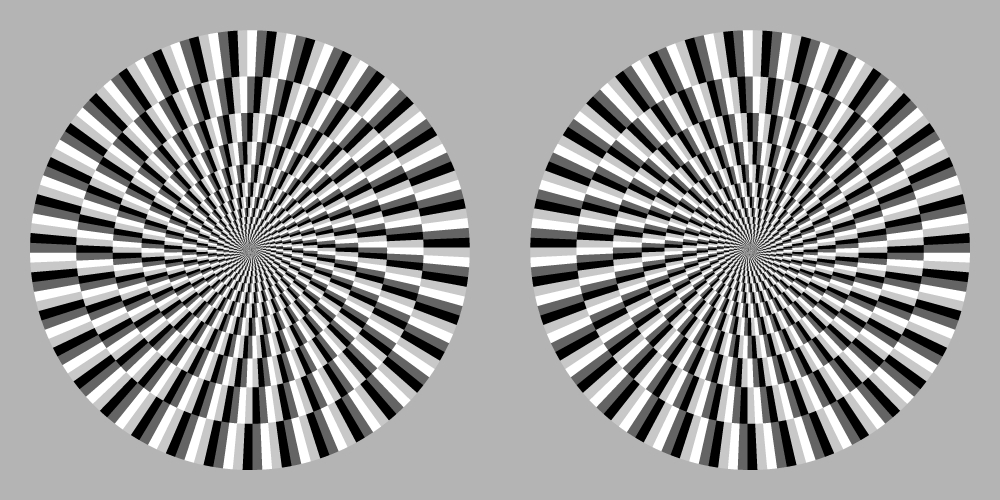
"Optimized Fraser-Wilcox" illusion
Kitaoka, A. and Ashida, H. (2003) Phenomenal characteristics of the peripheral drift illusion. VISION (Journal of the Vision Society of Japan), 15, 261-262. PDF
The direction of illusory motion is:
Black -> dark gray -> white -> light gray -> black
Tentative classification of this illusion
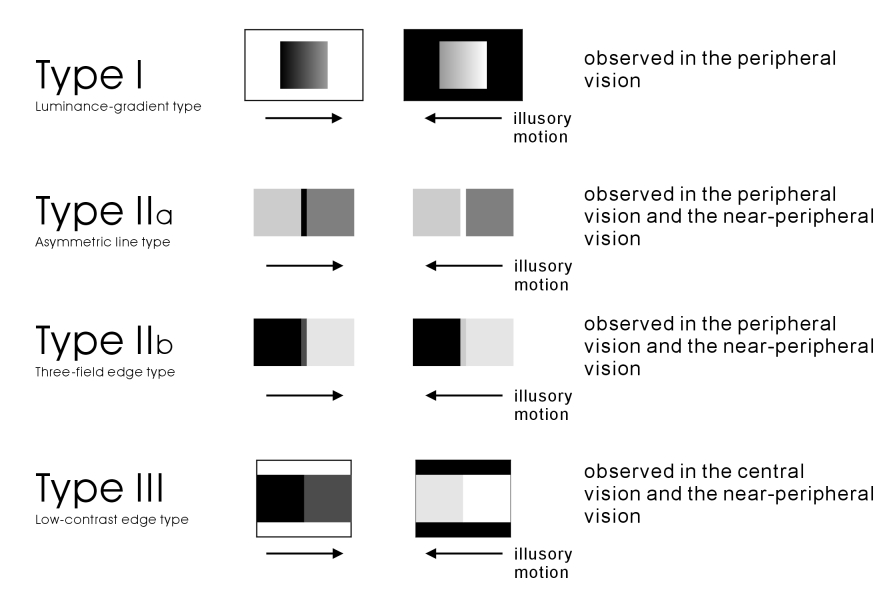
Murakami, I., Kitaoka, A. and Ashida, H. (2006) A
positive correlation between fixation instability and the strength of illusory
motion in a static display. Vision Research, 46, 2421-2431.
![]()
Backus, B. T. and Oruç, I, (2005) Illusory motion from
change over time in the response to contrast and luminance. Journal of
Vision, 5, 1055-1069. to get PDF
Conway, R. B., Kitaoka, A., Yazdanbakhsh, A., Pack, C.
C., and Livingstone, M. S. (2005) Neural basis for a powerful static motion
illusion. Journal of Neuroscience, 25, 5651-5656.
![]()
"Optimized Fraser-Wilcox" illusion, Type I
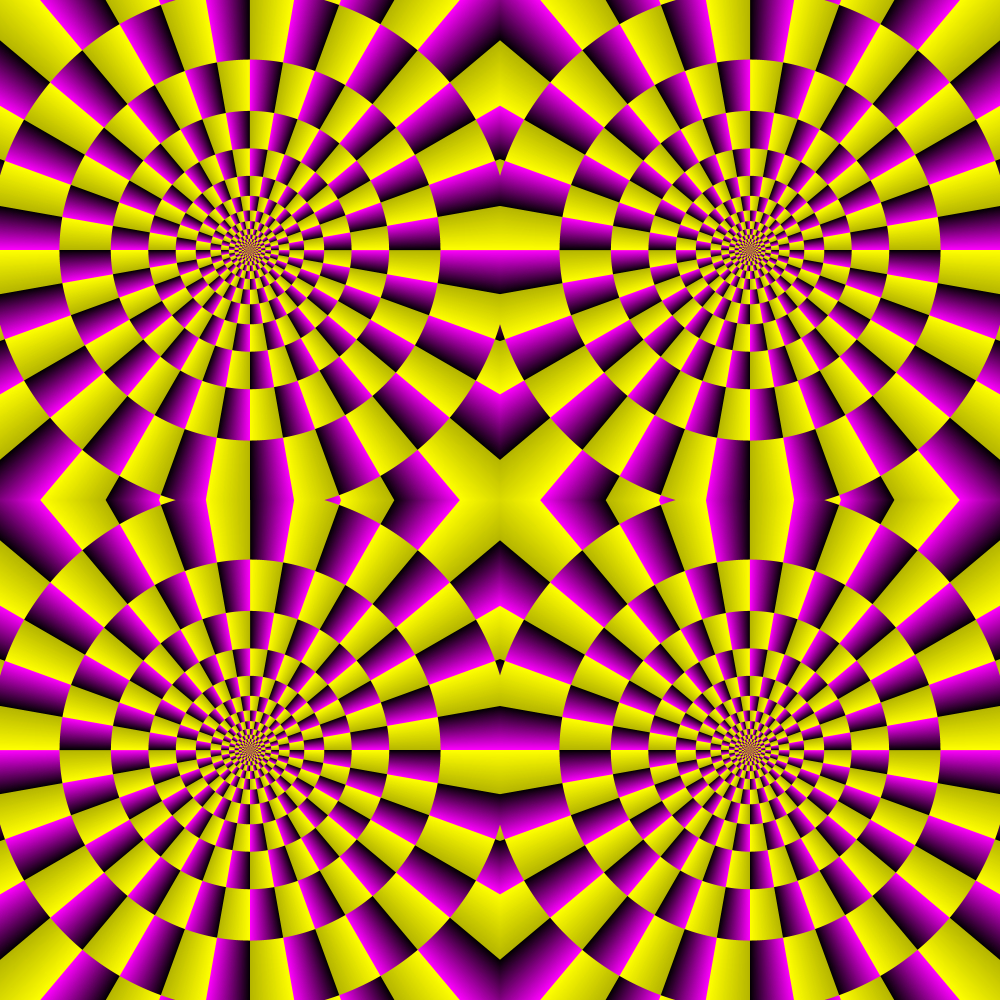
"The time tunnel show"
Rings appear to rotate.
Copyright Akiyoshi.Kitaoka 2006 (February24)
"Optimized Fraser-Wilcox" illusion, Type IIa
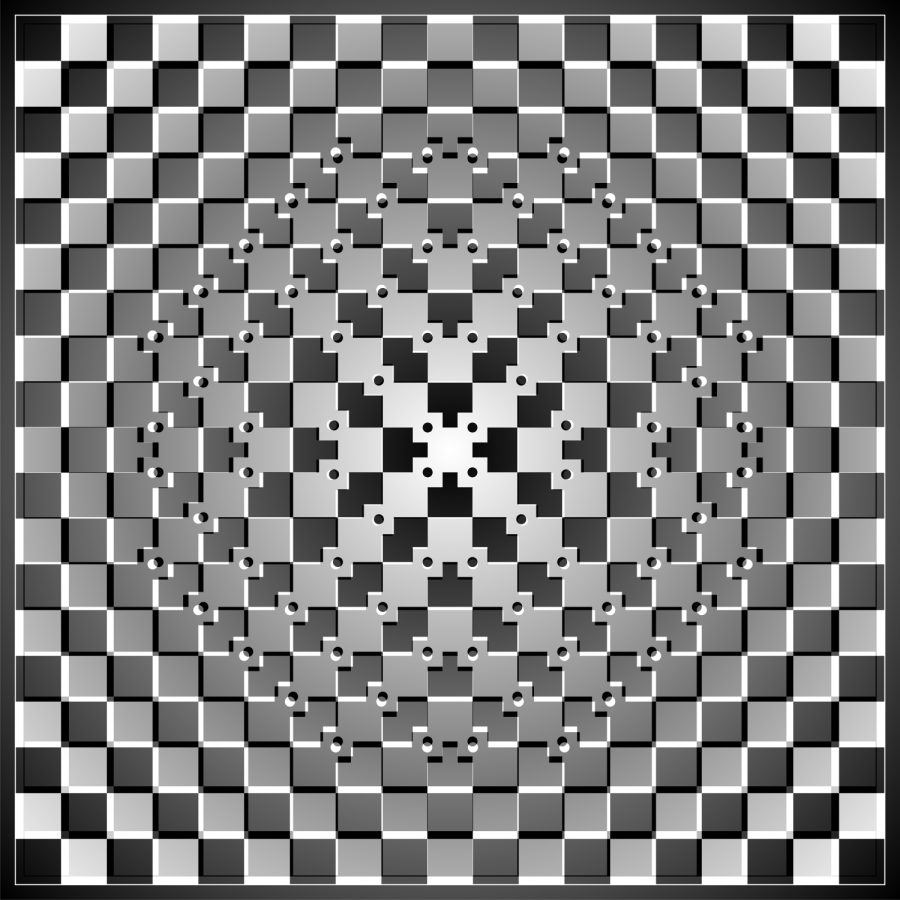
"Launch"
Something appears to be launched.
Copyright Akiyoshi Kitaoka 2008 (January 20)
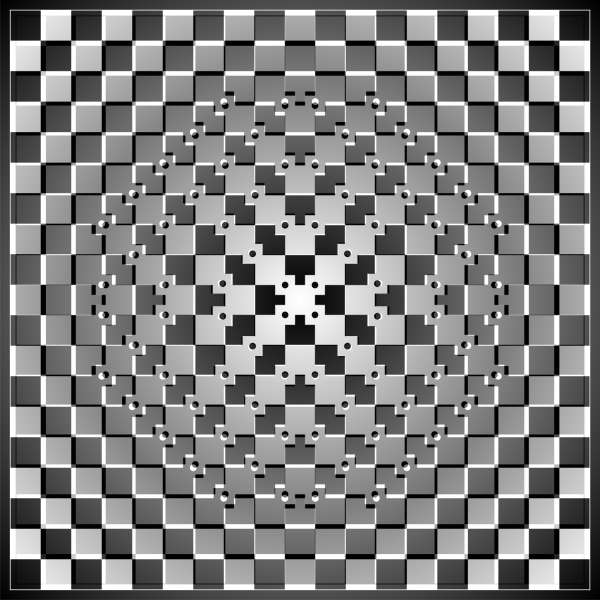
"Optimized Fraser-Wilcox" illusion, Type III
"Zig-zag worms"
The top and the third rows appear to move rightward while the rest appear to slide leftward.
Copyright Akiyoshi .Kitaoka 2007 (April 16)
Effects of color on the "optimized Fraser-Wilcox" illusion
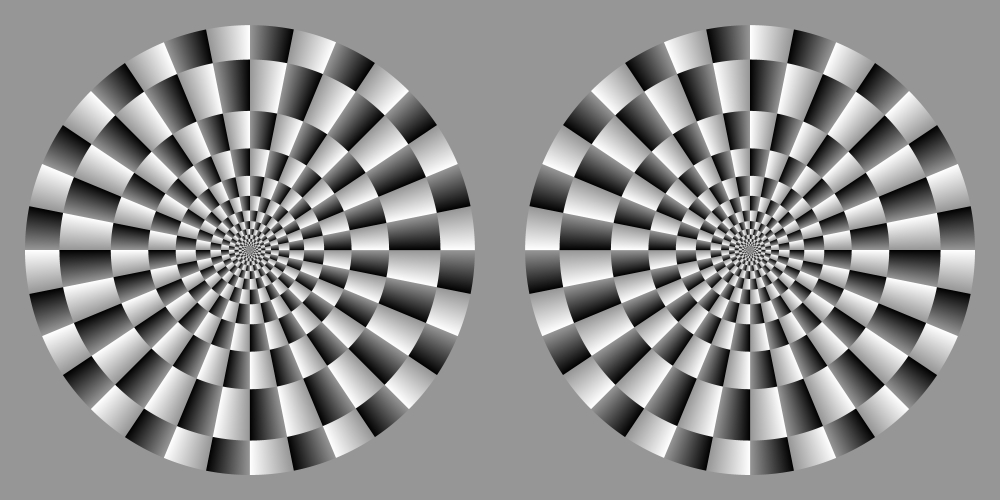
Black » Gray; White » Gray
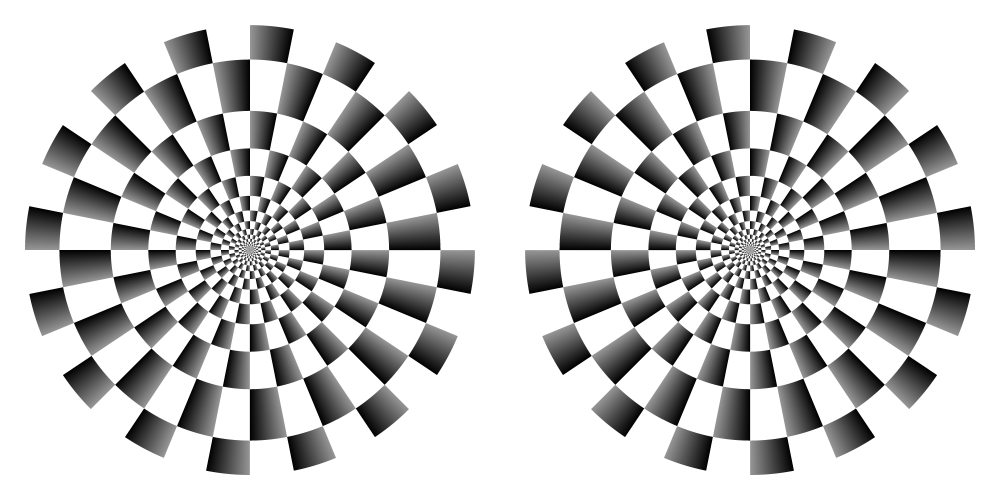
Black » Gray
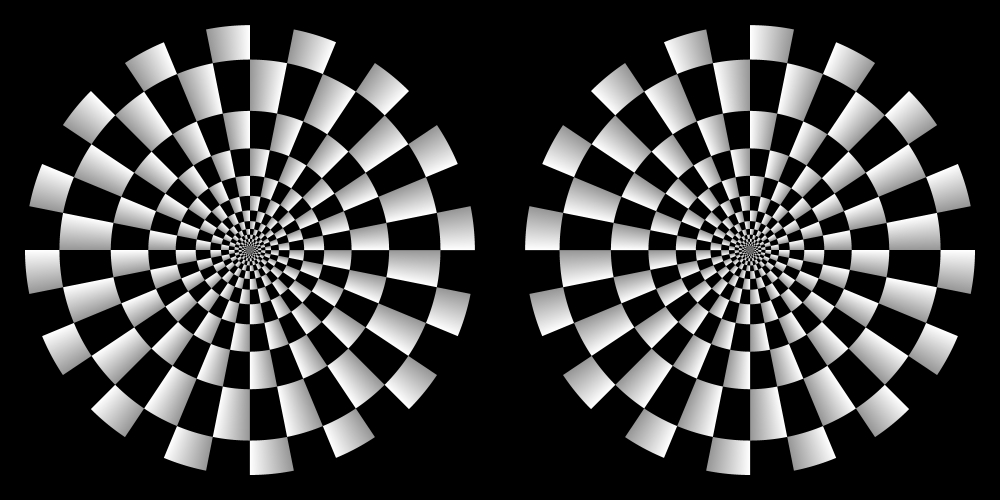
White » Gray
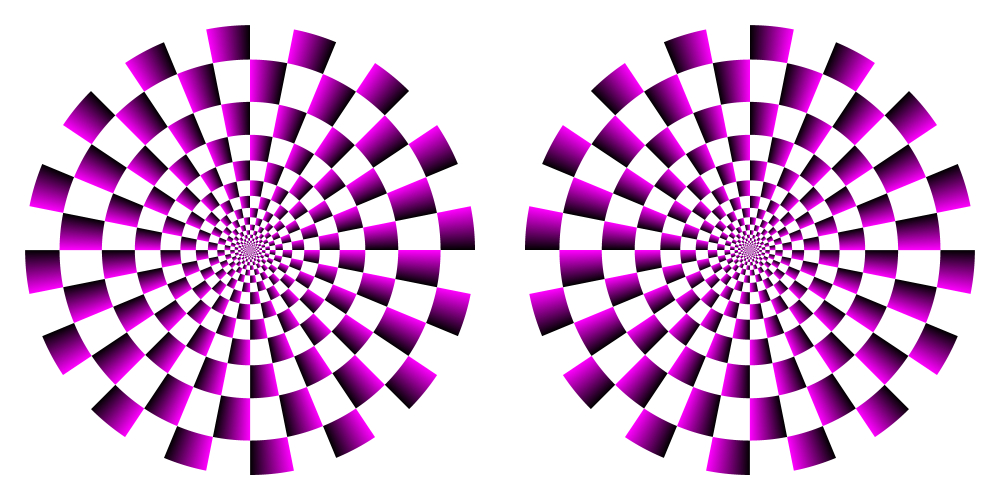
Black » Gray is replaced with Black » Magenta
Observation 1 The illusion from dark to light is enhanced by red or blue.
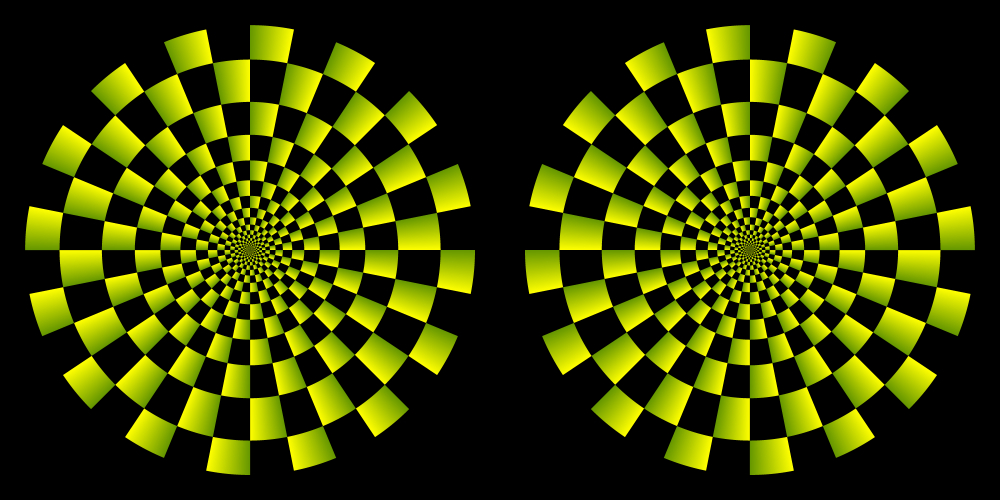
White » Gray is replaced with Yellow » Green
Observation 2 The illusion from light to dark is enhanced by yellow or green.
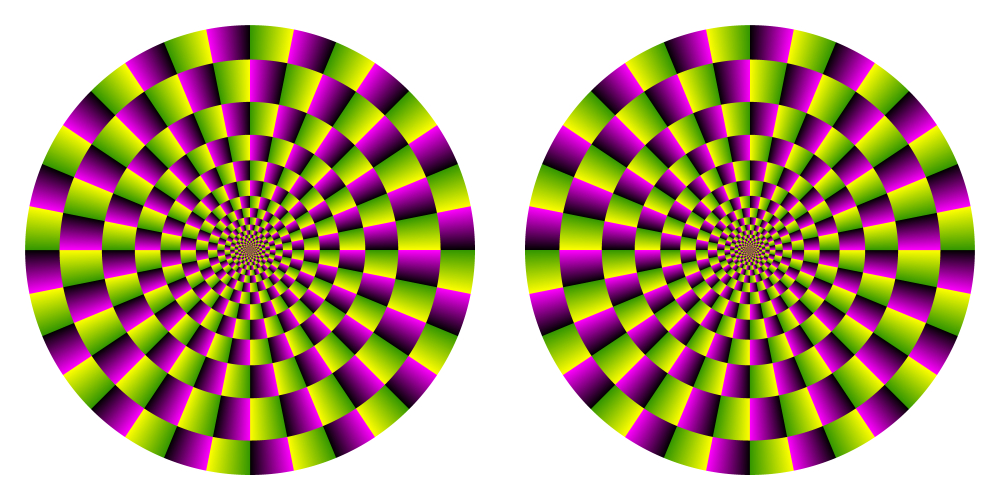
Black » Gray is replaced with Black » Magenta
White » Gray is replaced with Yellow » Green
Observation 3 The illusion from dark to light is enhanced by red or blue, and the illusion from light to dark is enhanced by yellow or green. Both illusions work additively.
 Suggested underlying mechansims
Suggested underlying mechansims
There are three explanations shown below.
Murakami, I., Kitaoka, A. and Ashida, H. (2006) A
positive correlation between fixation instability and the strength of illusory
motion in a static display. Vision Research, 46, 2421-2431.
![]()
Backus, B. T. and Oruç, I, (2005) Illusory motion from
change over time in the response to contrast and luminance. Journal of
Vision, 5, 1055-1069. to get PDF
Conway, R. B., Kitaoka, A., Yazdanbakhsh, A., Pack, C.
C., and Livingstone, M. S. (2005) Neural basis for a powerful static motion
illusion. Journal of Neuroscience, 25, 5651-5656.
![]()
Individual differences in Rotating snakes illusion
蛇の回転の個人差について
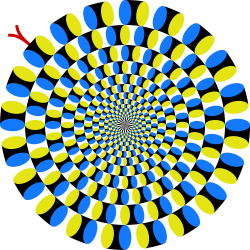

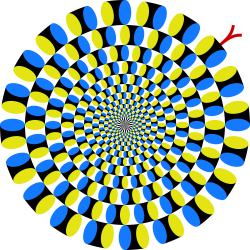
The relationship between the "Rotating snakes" illusion and age has been examined several times. Here are additional data from students of a high school and the Ritsumeikan University. The items for answer were "Rotating snakes appear to move well" (score 3), "Rotating snakes appear to move" (score 2), "Rotating snakes appear to move slightly" (score 1), and "Rotating snakes do not appear to move at all" (score 0). As a result, young people tend to see this illusory rotation strongly. <October 17, 2007>

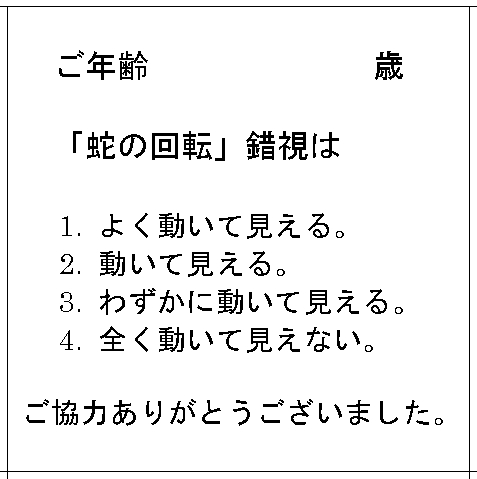
Survey card
Results
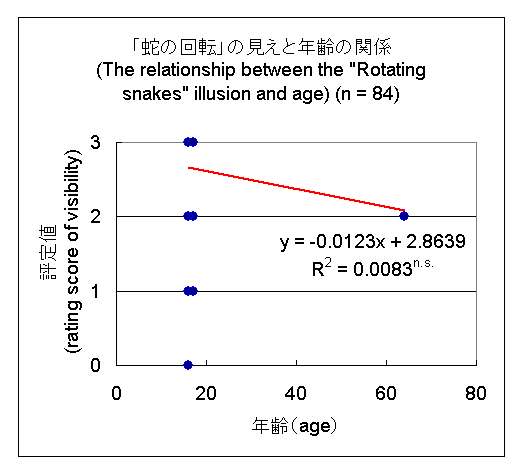
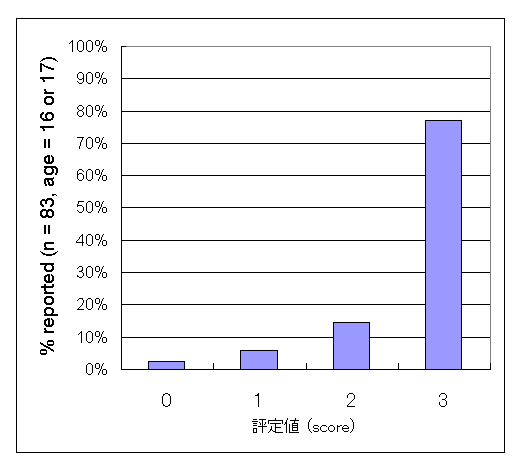
Data from high school students (with one teacher) (October 4, 2007). For scores, see text.
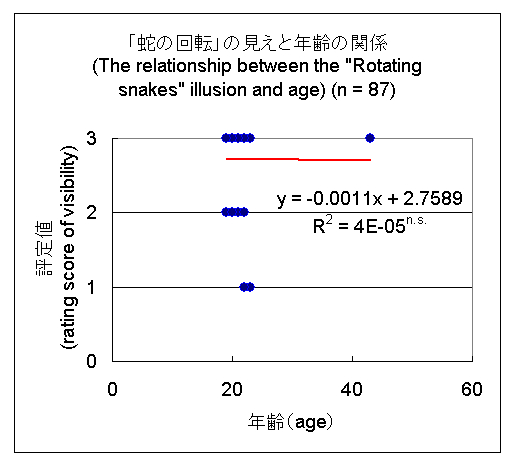
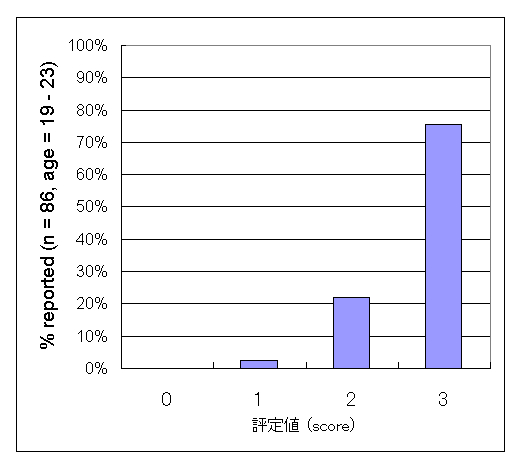
Data from Ritsumeikan University students (October 12, 2007).
The graph shown below displays the combined data that have been collected
so far. A strong negative correlation (r = -.46) was found between the
Rotating Snakes illusion and age! This does not necessarily mean that the
older the obeserver is, the less visible the illusion,
but indicates that some characteristic that is related to age but is not
related to quality of life affects the Rotating Snakes illusion.
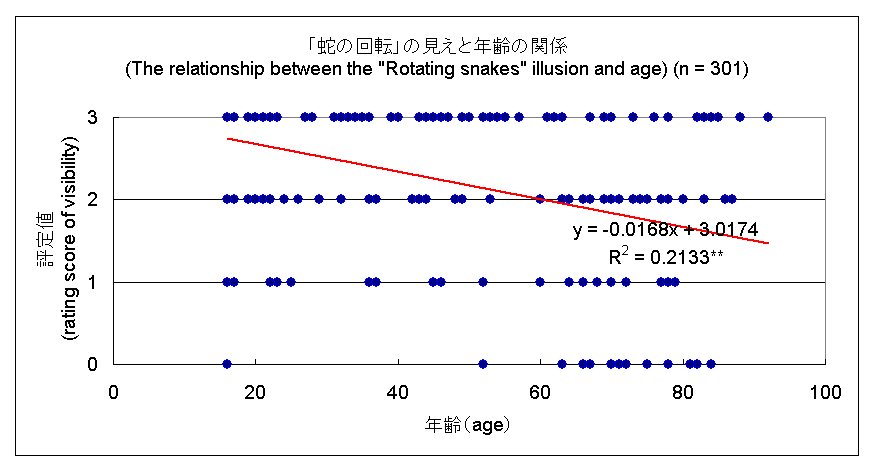
For those who do not see the "Rotating snakes" illusion, please do not worry because "no illusion" does not mean anything. It is only one of the individual differences. Please enjoy other illusions!
結果は、錯覚ニュース8に掲載いたします。
&
&

まとめ
Summary
錯視研究も数学の恩恵をいろいろ受けている。
The study of visual illusion largely depend on mathematics.
ご清聴ありがとうございました。
Thank you for listening.

Special thanks to Mimura-sensei, Matano-sensei, and Arai-sensei.
会議の名称:
非線形数理東京フォーラム
「人と自然の数理」
共催:
東京大学21世紀COEプログラム
明治大学先端数理科学インスティテュート
世話人: 三村昌泰(明治大学),俣野 博(東京大学)
日程:
2月2日(土)-3日(日)
場所: 数理科学研究科大講義室
http://www.ms.u-tokyo.ac.jp/access/index.html
テーマ1:
イリュージョンの世界
北岡明佳(立命館大)
「錯視と数学」
新井仁之(東大)
「ウェーブレットと視覚の数理モデル」
討論者:
山田道夫(京大),杉原厚吉(東大)
テーマ2:
社会行動の数理
青沼仁志(北大)
「クロコオロギの社会的適応行動」
巌佐庸(九大)
「The
leading eight: 評判をつかって協力を引き出せるか?」
討論者: 楠岡成雄(東大),嶋田正和(東大)
テーマ3:
ゆらぎの神秘
柴田達夫(広大)
「細胞内の確率的な情報処理」
合原一幸(東大)
「脳のデュアルコーディングとゆらぎ」
討論者:
甲斐昌一(九大),M.
Tribelsky(モスクワ工科大)
パネルディスカッション:
「数理モデリングの可能性と将来」
*****************************
【初日】
10:00-10:45
北岡
11:00-11:45 新井
11:55-12:30 (討論)
14:00-14:45 青沼
15:00-15:45
巌佐
16:00-16:30 (討論)
17:00-17:40
パネルディスカッション
【二日目】
10:00-10:45 柴田
11:00-11:45 合原
11:45-12:30
(討論)
会議のあり方:
単なる講演会でなく,討論の時間を設けています.
あらかじめ指名した討論者に議論の口火を切って
いただくとともに,会場の参加者からの質問や
コメントも随時受け付けます.
------------------------------